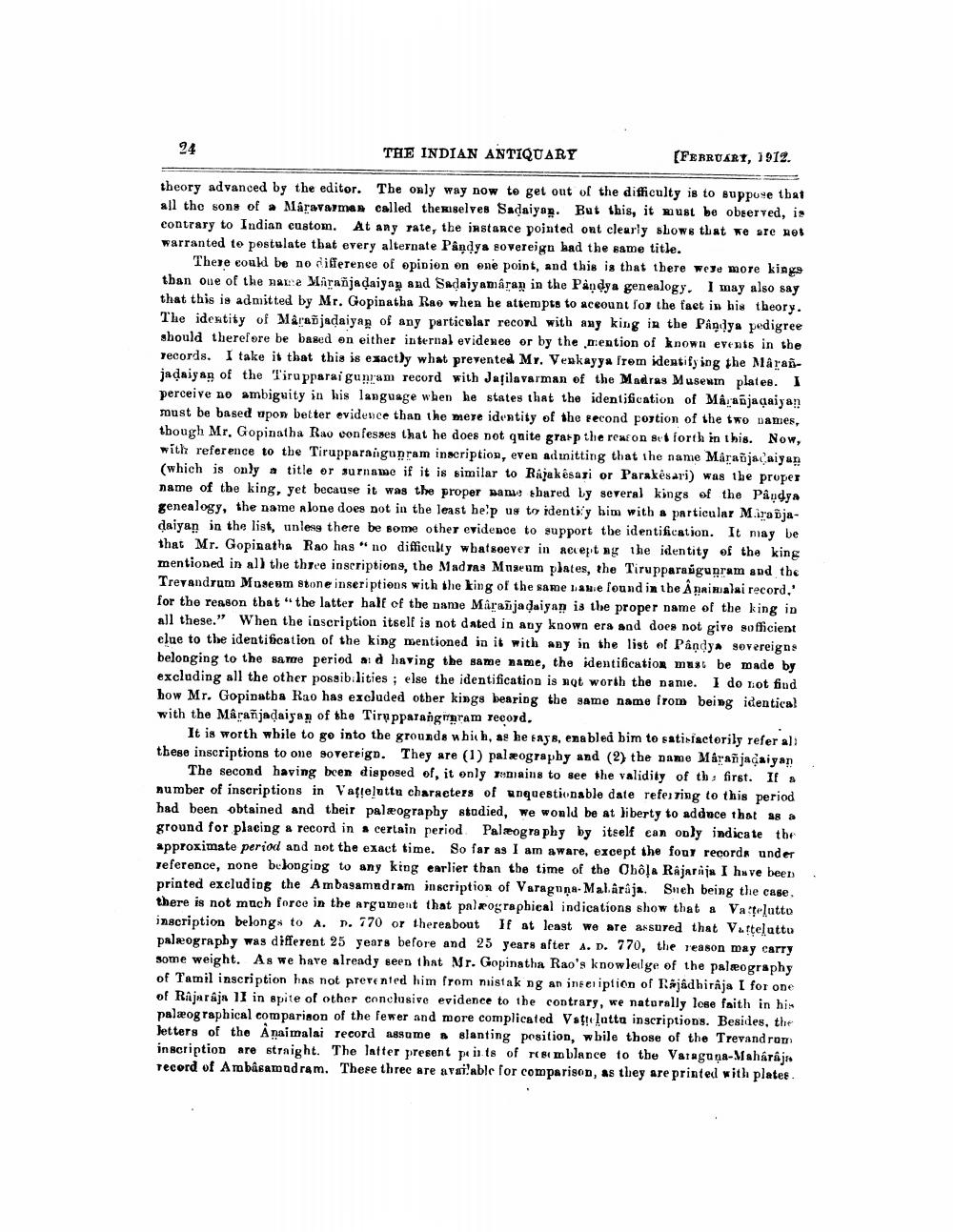________________
THE INDIAN ANTIQUARY
(FERRUART, 1912.
theory advanced by the editor. The only way now to get out of the difficulty is to suppose that all the sons of a Máravaymes called themselves Sadaiyap. But this, it must be observed, is contrary to Indian custom. At any rate, the instance pointed ont clearly shows that we are not warranted to postulate that every alternate Pandys sovereign had the same title.
These could be no difference of opinion on one point, and this is that there wede more kings than one of the Bee Marañjadaiyap and Sadaiyamaran in the Påndya genealogy. I may also say that this is admitted by Mr. Gopinatha Rao when be attempts to account for the fact is his theory. The identity of Marajadaiyan of any particular record with any king in the Pandya pedigree should therefore be based on either internal evidence or by the mention of known events in the records. I take it that this is exactly what prevented Mr. Venkayya frem identifying the Maranjadaiyan of the Tirupparai gunram record with Jatilavarman of the Madras Museum plates. I perceive no ambiguity in his language when he states that the identification of Mayanjaqaiyan must be based upon better evidence than the mere identity of the second portion of the two Dames, though Mr. Gopinatha Rao confesses that he does not quite grarp the reason set forth in this. Now, with reference to the Tirupparaigunram inscription, even adinitting that the name Maradjacaiyan (which is only a title or surname if it is similar to Rajakesari or Parakesari) was the proper name of the king, yet because it was the proper manis shared ly several kings of the Pandya genealogy, the name alone does not in the least help us to identify him with a particular Miraijadaiyan in the list, unless there be some other evidence to support the identification. It may be that Mr. Gopinatha Rao has " no difficulty wbatsoever in accept the identity of the king mentioned in all the three inscriptions, the Madras Museum plates, the Tirupparaugunram and the Trevandrum Museam stone inseriptions with the king of the same ase found in the Animalai record, for the reason that "the latter half of the name Marajadaiyan is the proper name of the king in all these." When the inscription itself is not dated in any known era and does not give sofficient elue to the identification of the king mentioned in it with any in the list of Pandya sovereigns belonging to the same period ad having the same name, the identification must be made by excluding all the other possibilities; else the identification is not worth the panie. I do not find how Mr. Gopinatha Rao has excluded other kings bearing the same name from being identical with the Marañjadaiyan of the Tirupparang oram record,
It is worth while to go into the grounds which, as he says, enabled bim to satisfactorily refer a); these inscriptions to one sovereign. They are (1) palæography and (2) the name Marañjadaiyan
The second having been disposed of, it only remains to see the validity of th: first. If number of inscriptions in Vateluttu characters of unquestionable date referring to this period had been obtained and their palæography stodied, we would be at liberty to adduce that as a ground for placing a record in a certain period Palæography by itself can only indicate the approximate period and not the exact time. So far as I am aware, except the four recorda under reference, none belonging to any king earlier than the time of the Chola Rajaraja I have been printed excluding the Ambasamudram inscription of VaragnnaMalaraja. Sneh being the case. there is not much force in the argument that paleographical indications show that a Va telatto inscription belongs to A. 1.770 or thereabout If at least we are assured that Vatteluttu paleography was different 25 years before and 25 years after A. D. 770, the reason may carry some weight. As we have already seen that Mr. Gopinatha Rao's knowledge of the palæography of Tamil inscription has not prevented him from mistak ng an inteription of Rajadhiraja I for one of Rajaraja 11 in spite of other conclusive evidence to the contrary, we naturally lose faith in his palæographical comparison of the fewer and more complicated Vatelatta inscriptions. Besides, the Jetters of the Anaimalai record assumes Blanting position, while those of the Trevandrom inscription are straight. The latter present points of resemblance to the Varagua-Maharaja record of Ambasamudram. These three are available for comparison, as they are printed with plates.




